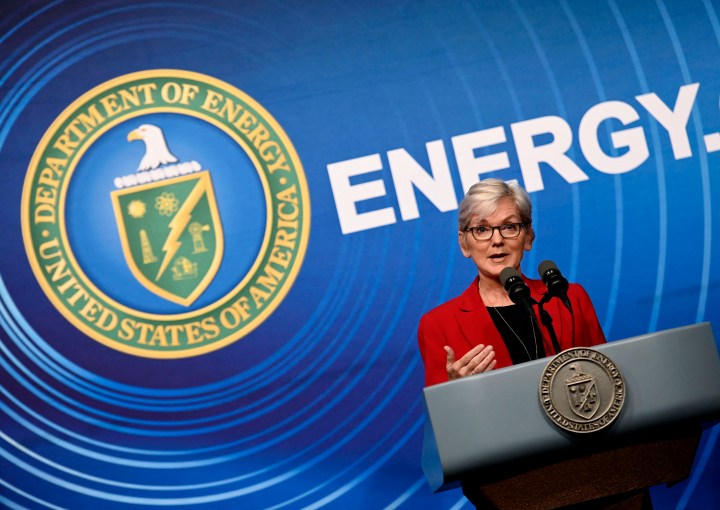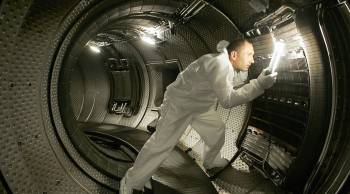
Are we still 30 years away from fusion energy? Some think the timeline’s shrinking.
Are we still 30 years away from fusion energy? Some think the timeline’s shrinking.

There’s a running joke in the nuclear fusion research community: Harnessing the thermonuclear reactions that power the sun and stars to produce abundant, clean, cheap energy here on Earth is always 30 years away.
But that timeline may have shortened a bit. Last week, the Department of Energy announced that scientists at the Lawrence Livermore National Laboratory in California finally managed to ignite a fusion reaction that created more energy than it took to sustain it.
That energy gain was a first — and took us one step closer to harnessing fusion as a source of plentiful carbon-free electricity.
Two stories underground, in the subbasement of the Physics, Math, and Astronomy Building at the University of Texas at Austin, Sandra Bruce pointed to one of the most powerful lasers in the world.
“So this is where the whole laser basically is,” she said. As associate director of the Center for High Energy Density Science at UT, it’s her job to take care of the laser.
“It’s basically all on this one table, the front end actually is in this, this black box here. And this puts out nanojoules of energy in each pulse. It’s really a very, very, very small amount of energy,” Bruce said. “And then the name of the game for the rest of this table is to add energy to this beam without burning anything.”
The table the laser sat on was covered with hundreds of mirrors that reflect and amplify the pulses until they strike a target packed with hydrogen. Hopefully, that happens with enough energy to fuse the hydrogen into helium and produce a lot more energy with no radioactive waste.
After about an hour of heating the laser up, operator Eli Medina prepared to fire it, speaking into a loudspeaker.
“Stand by for system shot checklist. Target and objective out. Motion motors off and unplugged? Alignment camera blocked? Overhead camera blocked, shut diagnostic arm?”
And then came the countdown. “Charge complete. Firing system shot. In 3, 2, 1, fire,” Medina said.
The shot lasted less than a trillionth of a second. It did not ignite the target, but it can provide an immense amount of data — which can be used in a complementary fashion, along with ignition data from the National Ignition Facility and similar sites — to push science toward a fusion-based future.
The person who essentially built this laser in the early 2000s while working at UT is Erhard Gaul. His approach to fusion — those short, consistent bursts — is different from the one in the Department of Energy’s announcement last week, which used 192 lasers to blast a target.
“We think there might be a chance to have maybe a more efficient way to reach fusion, but there’s still a lot of research to be done,” Gaul said.
These days, he said, using lasers to create blasts is just one way people are trying to harness fusion. Some labs use magnetic fields and plasma. The basic scientific discoveries in one camp inform the other, Gaul said.
He believes the appetite for fusion research is growing. And last week’s breakthrough in California should only spark new interest that will speed up timelines.
“I’m actually convinced it can be done in a reasonable time, but it takes funding,” Gaul said.
A lot of funding.
For decades, most, if not all, of that funding came from government. Then, five or 10 years ago, Gaul said, things started to shift and private investors got more and more interested.
Gaul made the switch to the private sector himself. He’s now responsible for laser development at a company based in Munich, which paid for about a month’s worth of experiments in the Austin lab.
It’s hardly the only company investing in fusion research, though.
“Last year, actually, there was more private money in the United States put into fusion, several times more private money put into fusion, than all the public money combined,” said David Kirtley, CEO of the Seattle fusion startup Helion Energy. When private capital is involved, companies have to show investors they’re getting their money’s worth.
“You have to have key milestones to prove that your technology is working, that you’re making progress, and you’re on your way to making generators,” Kirtley said.
Dozens of startups across the country are trying to do that. In Cambridge, Massachusetts, a company called Commonwealth Fusion Systems hopes to have most parts of a fusion power plant up and running by 2025.
CEO Bob Mumgaard said his company now has some 400 employees and has raised about $2 billion — almost all from private sources, including some companies that fusion would seem to compete with.
“Everything from large energy and gas companies like Eni, the Italian oil major, to Equinor, that Norwegian oil company, to Bill Gates and venture capitalists, to large institutional capital,” Mumgaard said.
Many scientists in fusion say the old joke about it always being 30 years away feels kind of tired now. They hope the fusion timeline is now down to something more like 10 to 15 years.
There’s a lot happening in the world. Through it all, Marketplace is here for you.
You rely on Marketplace to break down the world’s events and tell you how it affects you in a fact-based, approachable way. We rely on your financial support to keep making that possible.
Your donation today powers the independent journalism that you rely on. For just $5/month, you can help sustain Marketplace so we can keep reporting on the things that matter to you.

















